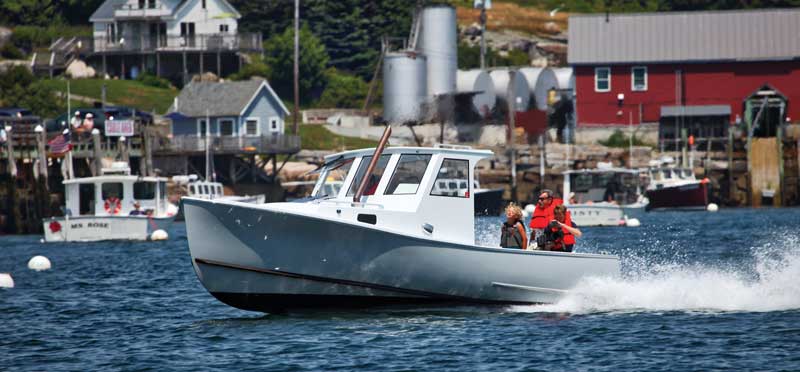
Some boats turn heads with their looks, others impress with their performance. With sailboats, beauty and speed often go hand in hand, but with powerboats? Sometimes, not so much. Give even an awkward-looking hull enough propulsion, and it can be speedy.
While I prefer the form and function relationship of sail, which seems to coalesce more naturally, every once in a while, a motorboat comes along that’s so crisp, sporty, and good looking it takes my breath away.
The lobsterboat racer Ripsnorter is the best example of that I’ve ever come across. Not only does it look stunning, but it has proven itself capable of ripping and snorting ahead of the pack.
Ripsnorter came to be, thanks to three talented men who met by chance, and only briefly, later in life. But each, in their own way, brought their skills into play.
One was Steve White, the former owner and jumpstarter at Brooklin Boat Yard, who stumbled upon the other two via a classified ad. What followed was a fortuitous melding of talent and ingenuity that resulted in something truly unique: a reimagining of a fishing vessel —in the same way a stock car racer is a souped-up hybrid of a Dodge, Ford, or Chevy. Ripsnorter looks fast, sounds fast, and with the throttle down, is fast.
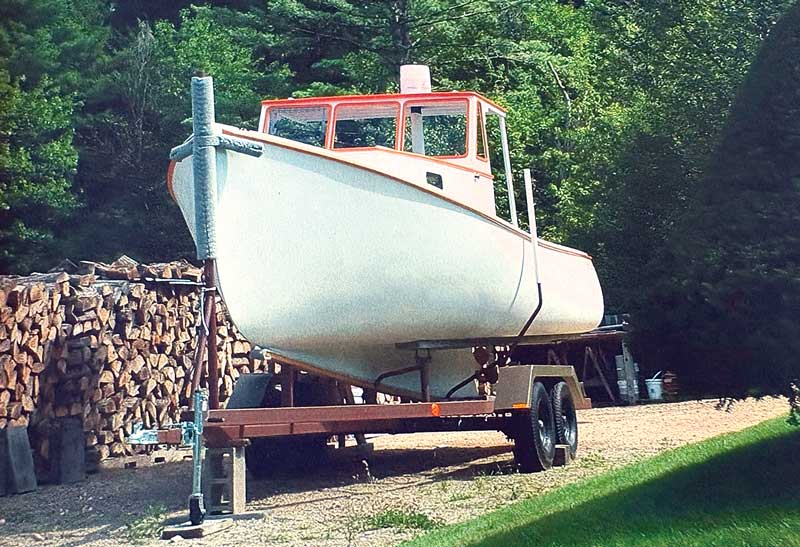
The Genesis of Two Cry Babies
In 1979, Bruce Lepage of Lewiston had no idea that a simple real estate transaction would change his life forever. When his backyard neighbor sold his house, a real estate agent involved in the deal remarked, “You and the buyer seem to have a lot in common.” That turned out to be an understatement.
Lepage’s roots run deep in the world of boats. Growing up in Falmouth, he fished for lobsters, starting with 12 traps and a homebuilt skiff, and eventually he managed 300 traps out of a 28-footer. He had a lobstering license then, and considered sticking with it, but ended up going to college and afterward found a career teaching math in Lewiston schools. But boats were always a part of him.
Meanwhile, his new neighbor across the fence was Jean Dubuc, a mechanical genius and car enthusiast, who shared a deep interest in boats. Dubuc had worked his way up to become the plant engineer at the Lewiston branch of the Johns Manville Corp., which made metal and rubber expansion joints for the roofing industry. His hobby was fast cars and gas engines, but he was also a boat nut, having grown up in Kennebunkport. And, he too had owned a lobsterboat.
They were soon fast friends. Both had dabbled in small-boat building, and they shared a keen interest in commercial fishing. As retirement loomed on their mutual horizon, they took on projects, sometimes involving engines, though Lepage specialized in wood working. (He told me “I’d proven I could build a boat, but Jean—He could build a whole car!”)
First, they built a motor-powered dory and thoroughly enjoyed the experience. Then upon retirement, they decided to throw in on a lobsterboat, but were stymied at first when they realized Maine fishery rules had tightened and they wouldn’t be able to get a license to haul traps.
Dubuc, through his car racing connections though, knew some fellows who participated in the Maine Lobster Boat Races. He talked about the fact that even if the duo couldn’t legally fish for lobsters, they might just try to go racing.
Little did the salty and tight downeast racing community know that these two were destined to “make good trouble.”
Building a legend
Lepage and Dubuc tackled their new hobby with the same intensity they’d applied to their lifelong careers. They studied race records, analyzed racing classes, and researched just what made a lobsterboat racer successful. Despite having had careers that required white-collar brains, they had a blue-collar mindset—and budget. They didn’t want to go head-to-head against so-called high liners who could spring for a half-million-dollar hull or a thousand-horsepower “mill.” Instead, they agreed to keep their boat small and trailerable, and attempt to build it out of components found at Home Depot, Mardens, online, and in junk yards.
As most of us frugal sailboaters know, half the fun is getting something for near nothing—like eking out speed for free from the wind. Lepage put it simply: “A lot of guys spend more on a summer of golf than we’ll spend building a whole boat.” In unison they said, “Let’s Do It!”
Right off, they decided to build their boat, Cry Baby, using cold-molded wood and West System epoxy, a technique promoted by Walter Greene, the famous Maine multihull designer and builder. He favored building with diagonal skins, preferably of thin plywood, and leaving the backup stringers in place.
Calling themselves D&L Boatworks, Dubuc and Lepage launched Cry Baby in 2005. The majority of the boat’s 25-foot hull was comprised of three layers eighth-inch thick underlayment from Home Depot. (The author bought a 4-by-8-foot sheet of similar plywood recently and noted the price had inflated to an astonishingly still-affordable $20.00) The resultant hull was about half the weight of other boats they’d be racing against in the six-cylinder gas class. The competitors in the class were traditional boats fashioned on long solid keels, with Maine cedar planking over white oak frames.
One smart feature of their design was to limit weight and resistance everywhere possible. Race rules, they noted, required a long skeg or keel and a functioning pot-hauler, but little else. They stayed within the rules but did something likely unprecedented: they built a hollow oak and plywood skeg and filled it with foam that was pared away at the shaft log tube to minimize water turbulence.
Cry Baby had a straight-six gas engine, which Dubuc modified to boost horsepower by 30 percent above stock. The relatively powerful engine in a short, light hull that was very flat aft went like blazes.
In eight seasons, Cry Baby almost never lost a race, even when pitted against V-8s! About the finest of many plaudits D&L Boatworks received was when lobsterboat builder Glenn Holland told the two something to the effect of, “Oh please don’t go into business against us.”
Having never lost money campaigning Cry Baby, the pair decided to take it up a notch, by building a slightly bigger (28 foot) version. Cry Baby 2’s hull got finished off the lines of a half model Lepage carved that was, “Just built-down a little bit more than the first boat.” They worked up an eight-cylinder engine with lots of modifications but then ran out of steam and put the second hull and motor up for sale. Both men were 83 at the time.
Talking by phone, after discussing the history of the boats I asked Lepage about the sale, and he didn’t seem all that upset, explaining that they’d had the time of their lives. He just said, “We got old.”
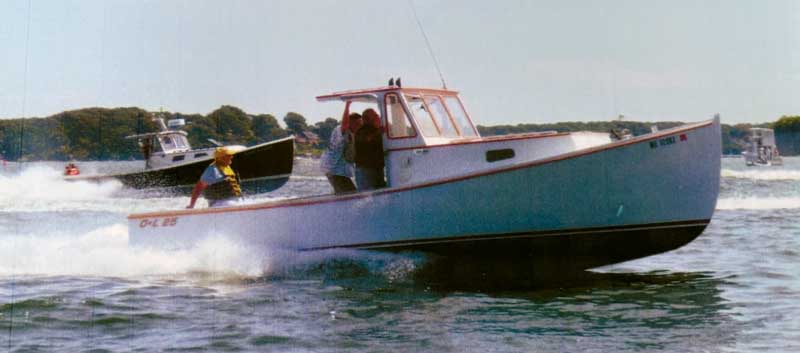
Cry Baby 2’s Second Wind
Steve White is a sailboat racing guy, which means he likes cheating the most speed from the slightest breeze. But one evening, while browsing the classified section of the Maine Coastal News and prospecting for bargains, he found an ad for a nearly complete 28-foot lobsterboat. He recalls the ad said the deal involved a “powerful gas engine. Can be purchased together or separately.” That was followed by a price that was unbelievably low. White called D&L Boatworks of Lewiston immediately.
Brooklin Boat Yard wasn’t in the market for a lobsterboat racer, but it seemed as though the hull might make a good yard boat for launch and towing work. He inquired about the engine, and when he heard about Isky cams, tuned headers, and ported and polished manifolds, he had qualms. “What do you run it on?” he asked. “Aviation fuel,” Dubuc told him.
They quickly settled on a price for the hull only, and in early 2023 the hull, which hadn’t had its wheelhouse started (it was being built in a low-ceilinged garage) was hauled to Brooklin Boat Yard.
The first order of business was to find an engine. White went hunting again and bought a much-used wooden launch on Great Cranberry Island called Raven. It had a 385 Mercruiser Chevy gas engine that was fuel injected and modern, with only a few hundred hours on it. The engine fit perfectly, and the team at Brooklin Boat Yard worked on the boat during slack times.
Over the years, I’ve talked with White about many of the yard’s builds and have written about them for this magazine. Most were inspired by designers, either in-house or from elsewhere. For this story, I asked White if he’d ever dictated a complete design. I figured he’d mention Vortex, a big sloop he’d beaten me with on several occasions, but he was kind enough not to go there.
Instead, over the course of five visits to Brooklin for this story, many there emphasized that White was by far the greatest factor behind the uniqueness of Ripsnorter—including the name.
I was told that Steve worked closely with carpenters and dreamed things up and put down pencil marks. He suggested things like, “curve that top about like this” or “chop that coaming right here.” He was full of great ideas but like his dad Joel and granddad E. B. White, he shied away from credit. He gets his way more collaboratively. People love him and he inspires them.
When the engine arrived, he got Nick Carter, the yard’s COO, to take charge of its installation along with most other mechanicals. They decided on a dry exhaust system, partly because the cockpit sole was already in place and the space below was too tight to try and bury an exhaust there. White liked the idea of running the exhaust stack right in front of the wheelhouse, at the same rakish angle as the windshield.
Much later, when I talked with the Lewiston boys about how the boat turned out, they criticized that stack pipe, perhaps unaware of how common they are way downeast.
I also discussed the exhaust pipe with Carter, saying that it seemed to me that a dry exhaust must be lighter to build and contribute less back pressure on the engine. He agreed.
I do want to note that the engine is still fresh water cooled through a heat exchanger. And that brought up yet another clever feature that White insisted on. The raw water exits out the side of the hull only a short distance from the engine box, but the yard installed a Y-valve for the clean ocean water to supply a hose that can be used to wash down the cockpit. (Not that bait pickle or fish gurry is part of the picture here. She’s only a mock-lobsterboat.)
As an aside, during one yard visit, Carter told me a great story. One day a cabin cruiser popped up on the yard’s VHF with a fire-related mayday call. Good old Ripsnorter was quickly manned and headed out, with its raw water hose all readied in order to play the part as Center Harbor’s fireboat. In the end it was discovered that there was no fire, just a cooked impeller. But the Y-valve idea had proved its potential worth.
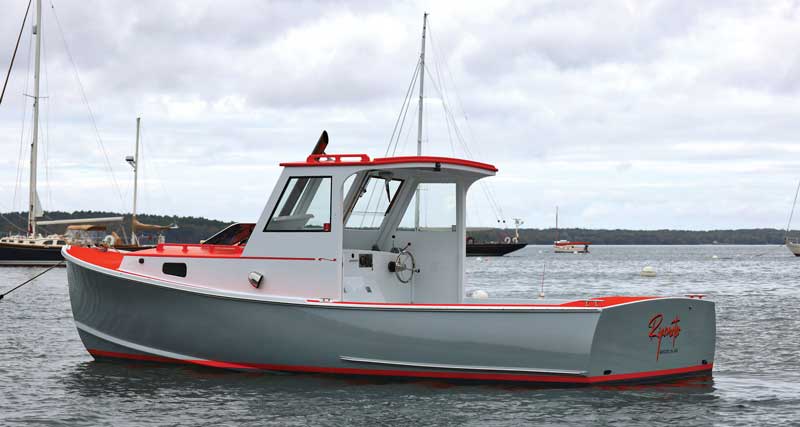
Racing Ripsnorter
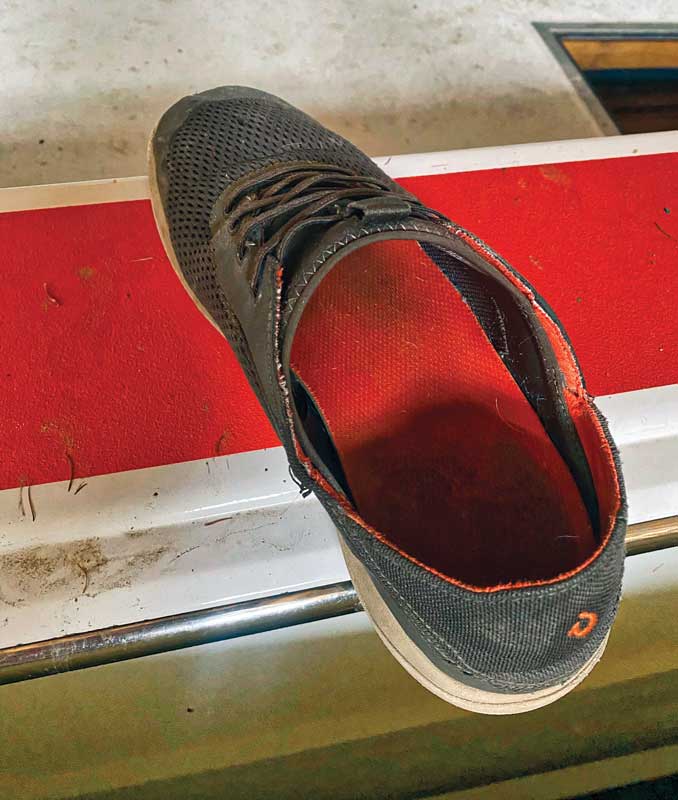
White always had it in mind to use the boat for racing too. Will Sturdy, Brooklin Boat Yard’s head designer, talked to him about a trial run they’d made, in which the boat bow-steered a bit and seemed to pitch forward into wakes. They knew that Cry Baby had benefitted by addition of spray rails, and Ripsnorter had a heavier engine than the smaller boat’s six-cylinder motor. Starr Blackwood was the lead carpenter for the Ripsnorter project. He consulted with Ryan Door, who’d worked at Atlantic Boat and was a real expert with lifting rails. He and Sturdy consulted closely on this aspect of the fit out, and once the rails were installed on this boat, they added more than 2 knots of speed and corrected the nose-diving.
By the summer of 2024 the whole boat yard was lusting for glory for Ripsnorter. The team swapped out the four-bladed prop for a three-bladed one, which is generally faster. Carter and Sturdy worked with Nautilus Marine to get a 16-by-16 prop with a number three cup. Trial runs and a video revealed that the prop cavitated a little when the throttle was wide open, and the crew heard the engine’s computer-controlled rev-limiter kicking in at times. There wasn’t time to make adjustments before heading to the races down in Stonington, but Ripsnorter was driven by Carter, with three people sitting aft in order to depress the stern. They won the two-boat contest handily.
Carter said they are considering installing a different computer chip to control the ignition timing and restrict the rev-limiter, allowing for higher horsepower, RPMs, and torque.
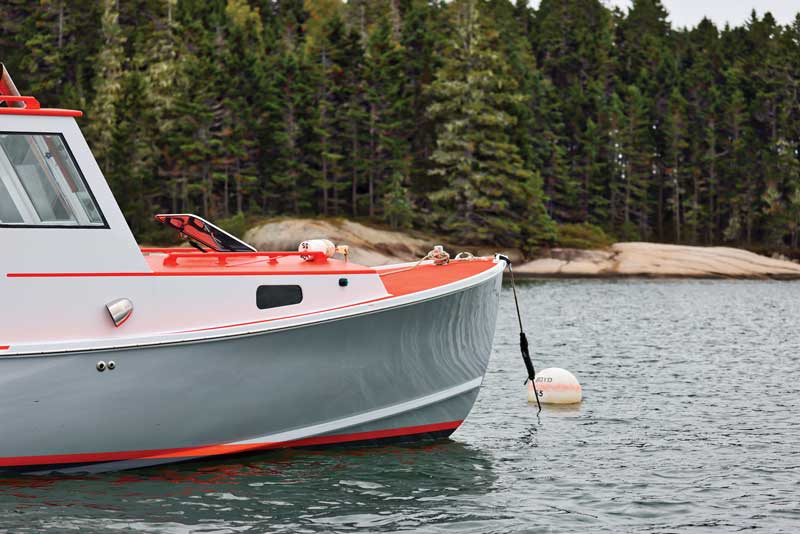
“Good Enough” Fit and Finish
Let’s conclude with the thing that got me so excited the first time I saw Ripsnorter: I’ll call it the boat’s artwork. I don’t care so much if the boat goes supersonic. All us Mainers think of lobsterboats as sturdy, reliable seagoing machines, built to handle any weather. Ripsnorter is a different animal. The high-gloss hull and superstructure finish clearly reflects Brooklin Boat Yard’s standards, although White and his crew dissed that notion, describing their “yard boat” as being simply “good enough.” In fact one day White showed up to discover that somebody (I know the culprit but swore secrecy) painted “Good Enough” on the cockpit coaming.
The BBY crew may see imperfections, but my eyes fail to see where. Instead, I see art everywhere, including the exhaust blower cowls that slant down and aft like tiny shiny JATO jets. The house windows are angular, the Awlgrip job is impeccable—its sheen and whiteness are somewhat the antithesis of a workboat. The grey hull is perfect, a workboat color but smooth and fair as a mirror.
All this blows me away. But surely the peak of outrageousness is expressed by the color of the boat’s top and deck. I couldn’t wait to ask White about it. “Oh, that?” he replied with a grin. “It came from my favorite pair of shoes.”
✮
Contributing editor Art Paine is a boat designer, artist, and writer who lives in Bernard, Maine.






